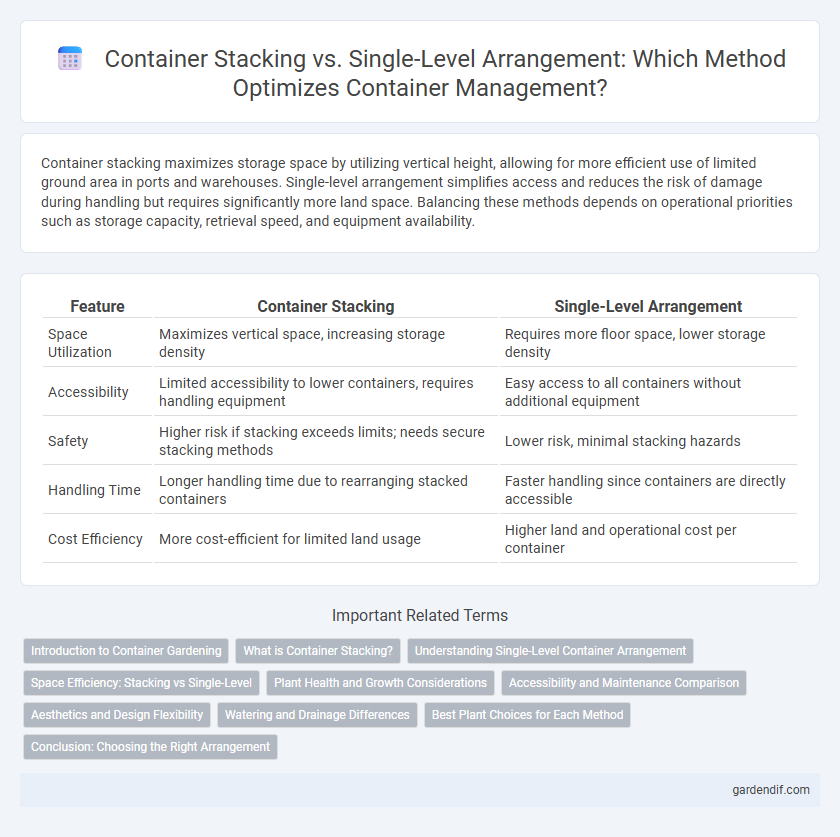
Container stacking vs single-level arrangement Illustration
Container stacking maximizes storage space by utilizing vertical height, allowing for more efficient use of limited ground area in ports and warehouses. Single-level arrangement simplifies access and reduces the risk of damage during handling but requires significantly more land space. Balancing these methods depends on operational priorities such as storage capacity, retrieval speed, and equipment availability.
Table of Comparison
| Feature | Container Stacking | Single-Level Arrangement |
|---|---|---|
| Space Utilization | Maximizes vertical space, increasing storage density | Requires more floor space, lower storage density |
| Accessibility | Limited accessibility to lower containers, requires handling equipment | Easy access to all containers without additional equipment |
| Safety | Higher risk if stacking exceeds limits; needs secure stacking methods | Lower risk, minimal stacking hazards |
| Handling Time | Longer handling time due to rearranging stacked containers | Faster handling since containers are directly accessible |
| Cost Efficiency | More cost-efficient for limited land usage | Higher land and operational cost per container |
Introduction to Container Gardening
Container stacking maximizes vertical space utilization, ideal for small gardens or patios, enabling more plants to thrive within limited areas. Single-level arrangement offers easier access for watering and maintenance but requires more horizontal space, making it suitable for larger outdoor settings. Both methods enhance container gardening versatility, catering to diverse spatial constraints and plant needs.
What is Container Stacking?
Container stacking refers to the practice of placing shipping containers one on top of another in a vertical arrangement to maximize storage space on ships, ports, or warehouses. This method improves spatial efficiency by utilizing height rather than ground area, allowing for higher capacity in limited spaces. Proper container stacking requires adherence to weight distribution and stacking strength standards to ensure safety and structural integrity during transport and storage.
Understanding Single-Level Container Arrangement
Single-level container arrangement maximizes accessibility by placing containers side by side on a single plane, facilitating faster loading and unloading processes. This method reduces the risk of damage and simplifies inventory management compared to stacking, which can lead to increased handling complexity and potential container deformation. Employing single-level layouts is particularly advantageous in terminals with high traffic and time-sensitive cargo operations.
Space Efficiency: Stacking vs Single-Level
Container stacking significantly improves space efficiency by maximizing vertical storage capacity, allowing multiple containers to occupy the same footprint. Single-level arrangements, while simpler to manage, require substantially more ground area and limit warehouse or yard space utilization. Efficient stacking systems reduce real estate costs and optimize logistics flow by enabling higher density storage within constrained spaces.
Plant Health and Growth Considerations
Stacking containers can limit airflow and light penetration, potentially increasing humidity levels and promoting fungal infections that hinder plant health. Single-level container arrangements enhance air circulation and sunlight exposure, supporting robust root development and optimal photosynthesis. Proper spacing in single-layer setups reduces stress factors and disease risk, fostering healthier, faster-growing plants.
Accessibility and Maintenance Comparison
Container stacking optimizes space but can hinder accessibility to lower units, requiring more effort and equipment for maintenance. Single-level container arrangements facilitate easier access for inspections, repairs, and loading, reducing downtime and labor costs. Maintenance efficiency directly improves with unobstructed container access, making single-level setups preferable in high-maintenance environments.
Aesthetics and Design Flexibility
Container stacking maximizes vertical space, creating visually dynamic and modular structures that enhance architectural aesthetics with bold, geometric patterns. Single-level arrangements offer greater design flexibility by allowing wider layouts and open spaces, ideal for integrating natural elements and diverse materials. Both approaches influence the overall style, with stacking emphasizing contemporary urban appeal and single-level prioritizing adaptability in design.
Watering and Drainage Differences
Container stacking reduces water drainage efficiency as lower containers receive limited direct water flow, potentially causing waterlogging and root rot risk. Single-level arrangements allow uniform watering and better drainage since each container has direct exposure to watering and adequate air circulation around the drainage holes. Proper assessment of container material and size also influences water retention and drainage capacity in both stacking and single-level setups.
Best Plant Choices for Each Method
High-density container stacking benefits from compact, robust plants like succulents and cacti, which thrive in limited soil and ensure efficient use of vertical space. In contrast, single-level arrangements are ideal for larger, moisture-loving plants such as ferns and begonias, allowing ample root expansion and better air circulation. Selecting plants based on container arrangement optimizes growth conditions and aesthetic appeal for each method.
Conclusion: Choosing the Right Arrangement
Selecting the optimal container arrangement depends on factors such as available space, load weight, and operational efficiency. Container stacking maximizes vertical space usage and is ideal for limited footprints, while single-level arrangements facilitate easier access and faster loading times. Balancing these considerations ensures improved safety, cost-effectiveness, and streamlined logistics performance.
Container stacking vs single-level arrangement Infographic

 gardendif.com
gardendif.com